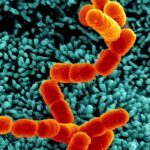Link to Pubmed [PMID] – 12569534
Electrophoresis 2003 Jan;24(3):421-40
A critical review of the existing theoretical models and experimental evidences for sieving mechanisms during separation of macromolecules, paying particular attention to capillary electrophoresis applications is presented. Gel models (Ogston and reptation) have been successfully applied to highly entangled polymer solutions, where fast and efficient separations can occur. In order to account for the DNA/polymers collision-interaction mechanisms during separation in dilute solutions – characterized by a poorer resolution -, approximated analytical models have been developed. An insight in the mechanism regulating the intermediate case of moderately entangled polymer solutions, for low fields and concentrations of small multiples of the overlap concentration c*, is given by the constraint release approach. This model proposes an upper limit of size separation, increasing with matrix concentration and molecular mass. Finally, the coupling between the reptative motion of the analytes and the effect of matrix constraint release very likely plays a fundamental role in the separation mechanism and requires therefore further and deeper investigation, both theoretically and experimentally.

